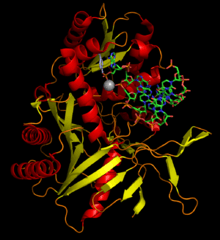Archaeoglobaceae
Archaeoglobaceae are a family of the Archaeoglobales.[1] All known genera within the Archaeoglobaceae are hyperthermophilic and can be found near undersea hydrothermal vents. Archaeoglobaceae are the only family in the order Archaeoglobales, which is the only order in the class Archaeoglobi.[1]
| Archaeoglobaceae | |
|---|---|
 | |
| The PIWI domain of an argonaute protein from A. fulgidus, bound to a short double-stranded RNA fragment and illustrating the base-pairing and aromatic stacking stabilization of the bound conformation. | |
| Scientific classification | |
| Domain: | |
| Kingdom: | |
| Phylum: | |
| Class: | |
| Order: | |
| Family: | Archaeoglobaceae |
| Binomial name | |
| Archaeoglobaceae Huber and Stetter 2002 | |
| Genera | |
| |
| Synonyms | |
| |
Mode of metabolism
While all genera within the Archaeoglobaceae are related to each other phylogenetically, the mode of metabolism used by each of these organisms is unique. Archaeoglobus are chemoorganotrophic sulfate-reducing archaea, the only known member of the Archaea that possesses this type of metabolism. Ferroglobus, in contrast, are chemolithotrophic organisms that couple the oxidation of ferrous iron to the reduction of nitrate. Geoglobus are iron reducing-archaea that use hydrogen gas or organic compounds as energy sources.[2]
Phylogeny
The currently accepted taxonomy is based on the List of Prokaryotic names with Standing in Nomenclature (LPSN)[3] and National Center for Biotechnology Information (NCBI)[4] and the phylogeny is based on 16S rRNA-based LTP release 106 by 'The All-Species Living Tree' Project.[5]
| ||||||||||||||||||||||||||||||||||||||||||||||
Notes:
♠ Strain found at the National Center for Biotechnology Information (NCBI) but not listed in the List of Prokaryotic names with Standing in Nomenclature (LPSN)
References
- See the NCBI webpage on Archaeoglobaceae. Data extracted from the "NCBI taxonomy resources". National Center for Biotechnology Information. Retrieved 2007-03-19.
-
- Madigan, M.T. & Martinko, J.M. (2005). Brock Biology of Microorganisms (11th ed.). Pearson Prentice Hall.
- J.P. Euzéby. "Archaeoglobaceae". List of Prokaryotic names with Standing in Nomenclature (LPSN). Archived from the original on 2011-06-13. Retrieved 2011-11-17.
- Sayers; et al. "Archaeoglobaceae". National Center for Biotechnology Information (NCBI) taxonomy database. Retrieved 2011-06-05.
- 'The All-Species Living Tree' Project."16S rRNA-based LTP release 106 (full tree)" (PDF). Silva Comprehensive Ribosomal RNA Database. Retrieved 2011-11-17.
Further reading
Scientific books
- Huber H; Stetter KO (2001). "Family I. Archaeoglobaceae fam. nov. Stetter 1989, 2216". In DR Boone; RW Castenholz (eds.). Bergey's Manual of Systematic Bacteriology Volume 1: The Archaea and the deeply branching and phototrophic Bacteria (2nd ed.). New York: Springer Verlag. p. 169. ISBN 978-0-387-98771-2.
- Huber H; Stetter KO (2001). "Order I. Archaeoglobales ord. nov.". In DR Boone; RW Castenholz (eds.). Bergey's Manual of Systematic Bacteriology Volume 1: The Archaea and the deeply branching and phototrophic Bacteria (2nd ed.). New York: Springer Verlag. p. 169. ISBN 978-0-387-98771-2.
- Stetter, KO (1989). "Group II. Archaeobacterial sulfate reducers. Order Archaeoglobales". In JT Staley; MP Bryant; N Pfennig; JG Holt (eds.). Bergey's Manual of Systematic Bacteriology. 3 (1st ed.). Baltimore: The Williams & Wilkins Co. p. 169.
External links
- NCBI taxonomy page for Archaeoglobaceae
- Search Tree of Life taxonomy pages for Archaeoglobaceae
- Search Species2000 page for Archaeoglobaceae
- MicrobeWiki page for Archaeoglobaceae
- LPSN page for Archaeoglobaceae